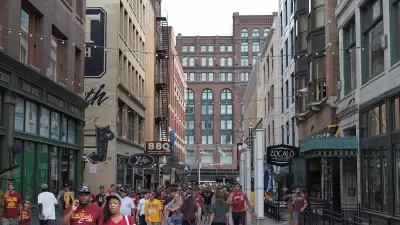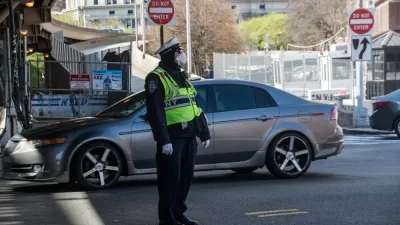East Cleveland, a struggling suburb of Cleveland, has ended up in so much fiscal distress that it is considering allowing Cleveland to annex it as a desperation move. We may need to rethink our decades of assumptions about home rule in the Northeast.

East Cleveland, a struggling suburb of Cleveland, has ended up in so much fiscal distress that it is considering allowing Cleveland to annex it as a desperation move. A fascinating article up yesterday on NextCity describes how it got to this point and the various tensions on each side about the merger idea.
On East Cleveland's side there is a proud community loathe to give up autonomy and control (not to mention a mostly-black community, some of whom told NextCity they are afraid of being subject to Cleveland's police force, which is currently under DOJ-mandated retraining as a result of its pattern of excessive use of force). And on Cleveland's side, a none-too-flush city is wondering why it (rather than the state) should bear the financial burden of helping its even more fiscally strapped neighbor, even if it would be nice not to have those issues right outside its borders.
It will be interesting to see where the idea ends up, but the proposal is striking in two ways: first, we may need to rethink our decades of assuming that home rule in the Northeast and Midwest is just too strong to allow us to overcome our fragmented tiny political bodies in favor of regional coordination. Ever since Myron Orfield and David Rusk started beating the "regional" drum, this has been the pushback. "That's great for the West, but here in the Northeast it'll never work." Never say never?
That's the optimistic angle. But Cleveland's hesitation about the annexation points to the other side of the coin:
FULL STORY: Cleveland–East Cleveland Merger Plan Overlooks Main Issue

Montreal Mall to Become 6,000 Housing Units
Place Versailles will be transformed into a mixed-use complex over the next 25 years.

Planetizen Federal Action Tracker
A weekly monitor of how Trump’s orders and actions are impacting planners and planning in America.

DARTSpace Platform Streamlines Dallas TOD Application Process
The Dallas transit agency hopes a shorter permitting timeline will boost transit-oriented development around rail stations.

Study: 4% of Truckers Lack a Valid Commercial License
Over 56% of inspected trucks had other violations.

Chicago Judge Orders Thousands of Accessible Ped Signals
Only 3% of the city's crossing signals are currently accessible to blind pedestrians.

Philadelphia Swaps Car Lanes for Bikeways in Unanimous Vote
The project will transform one of the handful of streets responsible for 80% of the city’s major crashes.
Urban Design for Planners 1: Software Tools
This six-course series explores essential urban design concepts using open source software and equips planners with the tools they need to participate fully in the urban design process.
Planning for Universal Design
Learn the tools for implementing Universal Design in planning regulations.
City of Mt Shasta
City of Camden Redevelopment Agency
City of Astoria
Transportation Research & Education Center (TREC) at Portland State University
US High Speed Rail Association
City of Camden Redevelopment Agency
Municipality of Princeton (NJ)





























